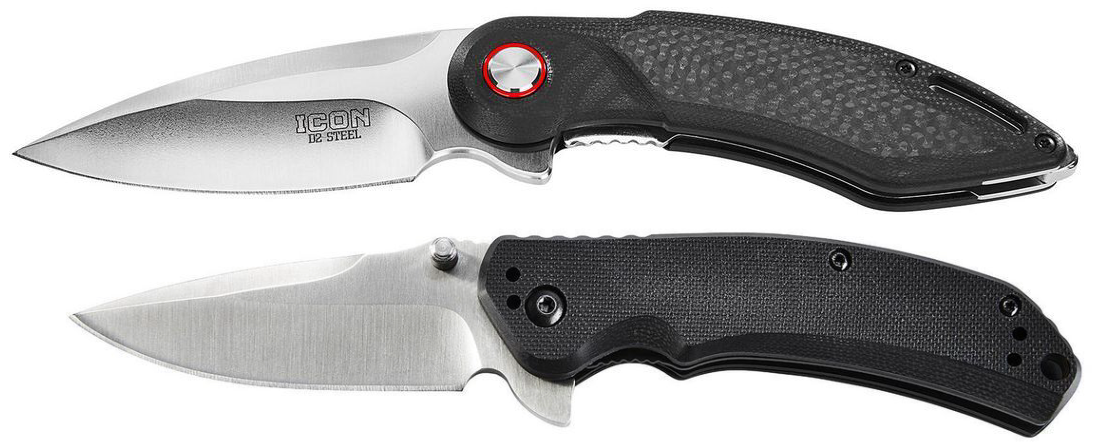Budget knives. Purchased from hardware, auto parts and tools stores. They just gotta be friggin’ fantastic, right? These stores would never stoop to selling us utter crap knives, right? Riiiiiiiight.
If you shop for your pocketknives at big box home, tools, and hardware stores like Home Despot, you’ll find a lot of low-cost options (mostly low-cost options, to be honest). They have multi-tools, razor utility knives, carpet knives (a genuine upgrade to utility knives, BTW), duct knives, insulation knives, and usually a selection of “pocketknives” made by unknown entities but labeled as tool manufacturer brands, such as Milwaukee, Husky, Craftsman, Kobalt, Klein, Stanley, Knipex, Dewalt, and more, including even less expensive, store-brand labeled stuff. Typically speaking, none of these pieces are very exciting, do not use anything but utilitarian designs, use low-end materials, and typically are of low-to-much-worse quality. While I can sound like a knife snob here, I must admit that these knives sell quite well. Sometimes contractors and construction workers just need a cheap, generic knife to cut cheap, generic stuff. Fine.
But in this muddled morass of mediocrity, sometimes an interesting surprise emerges. We all know the iconic, low-cost tools and equipment store, Harbor Freight. They have over 1,500 stores across the US, in nearly every state (sorry, Alaska, Hawaii, and Washington. DC!). They are best known for their foreign-made, truly budget-priced and budget-quality products. Truly budget-level stuff and little more.
According to their website, if you search for “knives”, they have 164 matches. Only 2 of those 164 products are priced above $100, and both are 15-amp portable thickness planers (knives in the loosest sense, right?). After that, they have 4 more items above $50, including a pry bar, a chisel set, radiator hose pick set, and a wood lathe chisel set (these are knives??). After that, nothing is more expensive than $40. Most of this stuff is no more related to knives than the listed 1-gallon jug of tube sealant for $35! (They really need to work on their inventory management.) However, they do have a few multi-tools, fixed blades, machetes, X-acto-style hobby knives, razor utility knives, and a very small number of what you and I would recognize as pocketknives.
There is a Harbor Freight store within a 30-minute drive from my home, and I was there recently. I noticed they had a couple of pocketknives on the shelf among the aisles of low-cost socket sets, hydraulic jacks, plastic tool chests, air compressors and welding blankets. I picked up a few things, which included a pair of their store-brand pocketknives.
This post is about that pair of Harbor Freight folding pocketknives. Spoiler alert: I actually didn’t puke when I opened them up and examined them. In fact, one was fairly interesting, so I wanted to share with you my Harbor Freight Budget Pocketknife Showdown (aka Knife Fight) between their premium-branded Icon Drop Point Knife with Ceramic Bearings and their budget-branded (how budget can a budget store go?) Gordon 2.9 in. Drop Point Pocket Knife (aren’t these creative names just precious?). Let’s get into this!
TL;DR
Harbor Freight sells a couple of low-priced (sub-$40) budget pocketknives. Are they any good? Well, they’re not spectacular (of course! What low-cost budget knife is)? However, in context to their cost, the low-cost budget knife world has come a very long way since only just a few years ago. If you can’t afford a new Benchmade (who can?), then the budget pocketknife world can still be a good category in which you can focus your shopping attention.
I recently went to Harbor Freight, a store that is renowned for their inventory of inexpensive, imported goods of often dubious quality. I saw 2 folding pocketknives (the Icon and the Gordon) on their shelves that were cheap. One inexpensive knife ($40) has had a lot of controversy associated with it, and the other’s price is just ridiculously low ($10)! So given my current knife budget (also ridiculously low), I decided to take a look at these 2 presumably low-end cutters. What did I find? Well, they were better than I thought (although the bar was admittedly quite low), especially for one of these knives.
Pros
- Both knives: Cheap!
- Both knives: Bearings in the pivot
- Icon: D2 blade
- Icon: Blade grind lines are crisp
- Icon: Milled G-10 scales with chamfered edges
- Icon: Well-fitted carbon fiber inlays
- Icon: Captive, flat milled pivot with bright red pivot collar
- Icon: Raised liner lock release tab enables easily accessed release
- Icon: Polished steel backspacer whose end extends slightly past handle (maybe a glass breaker? Not pointed, though)
- Icon: Nested liners
- Icon: Milled steel pocket clip
- Gordon: Thumb studs
- Gordon: Hollow-ground blade
- Gordon: Ambi pocket clip
- Gordon: Textured scales for good grip
Cons
- Both knives: Flipper tabs are not jimped
- Both knives: Fasteners are too soft and easily stripped
- Both knives: Out-of-the-box were barely sharp at all
- Gordon: Significant double-clutch in the detent
- Gordon: Substantial pivot lash, allowing blade to rattle before locking in
- Gordon: Liner lock is way too difficult to disengage
- Gordon: Super tight pocket clip will shred pocket fabric, if you can clip it on
- Icon: Flipper tab must overcome very heavy detent
- Icon: Needs a second method of opening the knife, such as thumb studs
- Icon: Raised liner lock release tab digs into index finger when open
- Icon: Scales are slippery smooth
- Icon: No jimping anywhere
- Icon: Non-ambi pocket clip
- Icon: Looks very similar to another company’s line of knives
Tech Specs
Brand | Icon | Gordon |
Website | ||
Manufacturer | Unknown | Unknown |
Origin | China | China |
Model Reviewed | Icon KDP3 IK24 | Drop Point Pocket Knife 57584 GK24? |
Designer/Design | Influenced by Todd Begg (his Begg Knives Mini Glimpse 2000) ? | Unknown |
Model Launch Year | 2023 | 2021 |
Style | Folding knife | Folding knife |
Lock Type | Liner lock | Liner lock |
Opening Type | Manual | Manual |
Opening Mechanism(s) | 1. Flipper tab | 1. Thumb studs 2. Flipper tab |
Pivot Type | Captured, flat milled stainless-steel pivot with T8 socket | Large, black, button-top screw with T8 socket |
Pivot Mechanism | Ceramic ball bearings | ball bearings |
Length Closed | 111.76 mm (4.40") | 105.66 mm (4.16") |
Length Opened | 189.27 mm (7.45") | 178.58 mm (7.03") |
Weight | 110.24 g (3.89 oz.) | 101.65 g (3.59 oz.) |
Weight-to-Blade-Length Ratio | 1.22 | 1.23 |
Original Packaging | Printed straight tuck end with plastic hang tab cardstock box with clear plastic box window, orange foam mold to secure the knife. | Half trapped blister packaging with full card |
Edge | Plain | Plain |
Shape | Drop Point | Drop Point |
Material | D2 | 8Cr13MoV |
Claimed Hardness HRc | Unknown | Unknown |
Blade Length | 80.13 mm (3.16") | 74.90 mm (2.95") |
Cutting Edge Length | 73.39 mm (2.89") | 72.47 mm (2.85") |
Primary Bevel Angle | 5° | 4° |
Original Edge Angle | Show side: 20° Clip side: 18° | Show side: 23° Clip side: 16° |
Height | 29.58 mm (1.16") | 25.68 mm (1.01") |
Thickness | 3.23 mm (0.127") | 2.60 mm (0.10") |
Main Bevel Edge Thickness | 0.58 mm (0.023") | 0.72 mm (0.028") |
Thumb Studs Span | N/A | 13.68 mm (0.54") |
Finish | Satin | Satin |
Features | Downswept, compound-grind (swedge, flat & primary bevel), fine satin-finished drop point blade | Compound-grind (swedge, flat & hollow-ground primary bevel), satin-finished drop point blade |
Grind | Sabre grind | Hollow, saber grind |
Swedge | 76.54 mm (3.01") at an angle of 16.44° | 56.04 mm (2.21") at an angle of 13.53° with visible grind irregularities |
Fuller | None | None |
Jimping | None | Coarse, moderate-depth, biting 4-cut jimping on blade thumb ramp. Also includes coarse, shallow 6-cut jimping on handle above the pivot. Note that handle and blade jimping don't sync. |
Blade Markings | Show side: Large brand logo with steel name underneath in rear of primary bevel. | Show side: None |
Sharpening Choil | Yes (Very large) | Yes (Large) |
On-Blade Opening Assists | Flipper tab | Thumb studs, flipper tab |
Materials | G10 with carbon fiber overlay | Listed as “composite”; likely fine texture peel G10 |
Color | Black | Black |
Scale Thickness (includes liner) | 3.91 mm (0.154") | 4.23 mm (0.167") |
Scale Texture | Extremely fine (almost smooth) G10 with smooth carbon fiber inlays | Canvas textured |
Handle/Scale Features | Almost contoured handle with well-chamfered edges and recessed milled region around pivot and extends to liner lock access. Liner lock access is raised higher than handle, allowing for very easy access. | Downswept handle with bevel-cut edges (shallower along bottom) with finger scallop at liner lock access. Liner lock is extremely tight out of the box. |
Liners | Nested steel | Stacked steel |
Opening Stop Pin Type | Dual-sided, on-blade stop pins | Floating pin in handle |
Closing Stop Pin Hits Sharpening Choil | No | No |
Handle Length | 111.76 mm (4.40") | 105.66 mm (4.16") |
Blade-to-Handle Ratio | 0.72 | 0.71 |
Closed Handle Height | 32.81 mm (1.29") | 31.27 mm (1.23") |
Handle Thickness | 12.73 mm (0.50") | 12.78 mm (0.50") |
Blade Tang-to-Liner Lock-up % | 25% | 66% |
Pivot Center-to-Thumb Stud | N/A | 21.32 mm (0.84") |
Thumb Stud-Angle-from-Vertical Center when closed | N/A | 34.5° |
Thumb Stud Tip-to-Scale-Edge Clearance: Show Side / Clip Side | N/A | 4.83 mm (0.19") |
Pivot Center-to-Open-Knife Fulcrum | 17.98 mm (0.71") | 17.15 mm (0.68") |
Flipper Tab from Pivot Center | 96° | 98° |
Integral Handle | No | No |
Backspacing Type | Raised backspacer with frag texture | Standoffs |
Backspacing Material | Stainless steel | Stainless steel |
Backspacing Color | Polished steel | uncoated steel |
Backspacer Length | 39.61 mm (1.56") | N/A |
Backspacer Features | Polished steel with 8-cut crenulation texture extending 2.33 mm / 0.09" beyond back of handle | None |
Lanyard Mount | Long, curved lanyard slot | Lanyard hole |
Pocket Clip | Milled deep-carry | Stamped medium-carry depth |
Clip Material | Stainless steel | Steel |
Clip Color & Finish | Curved, single-stepped with stonewashed finish | Black-painted clip with rounded tab that points up 26° at end |
Clip Placement | Non-ambidextrous, tip-up | Ambidextrous, tip-up or tip-down (tip-down by default) |
Clip Length | 54.05 mm (2.13") | 50.50 mm (1.99") |
Clip Length-to-Handle % | 48.40% | 47.80% |
Clip Features | Tumbled finish, curved clip with recessed curve on top edge | Straight clip that narrows toward contact patch then rises up to a flat spoon tip |
Fasteners | 2 black-coated steel T6 screws per side, easily stripped | 2 black-coated steel T6 screws per side, easily stripped |
The Icon Knife Imbroglio
Before we begin, I want to address an ongoing controversy with the Icon knife. Since its release in (I believe) 2023, many people have noticed a resemblance to the Begg Knives Glimpse. Many claim the Icon is an exact replica of the Begg knife (which, if it was true, as the knife is rebranded as Icon, would make this a clone, not a counterfeit – but it’s not a true clone). While this specific issue related to the Icon and the Glimpse knives is not the main topic of this article, the matter shouldn’t be ignored. So let’s take a look at what’s behind the argument.
Stolen Design?
The Glimpse series of knives, designed by Todd Begg, was released by Begg Knives starting in 2000. In the open position, the Glimpse featured a visually interesting, downward swept, curved arc from the tip of the blade to the end of the handle. The satin-finished, plain-edged, drop-point, D2 blade included a saber-ground bevel, a long, prominent swedge, and an extended, narrowing flat. The handle featured fine-textured G10 scales with 3 uncoated fasteners (including one of the pocket clip screws), a captive, plain, shallow-domed, collarless pivot running on ball bearings, a flipper tab located within a cut-out section of the handle spine, a liner lock with a raised, easily accessible raised release tab, and a clipped-sawtooth, steel backspacer. The curved, non-ambi, tip-up pocket clip was made from stamped steel and featured a curved cut-out for most of its length and used a large ball bearing at the end to make contact with the scale.
Take a look at the images below. They start with open knives, both sides, the Glimpse appearing above the Icon, then finishes with closed knives shown in the same order.
Begg Knives Glimpse:
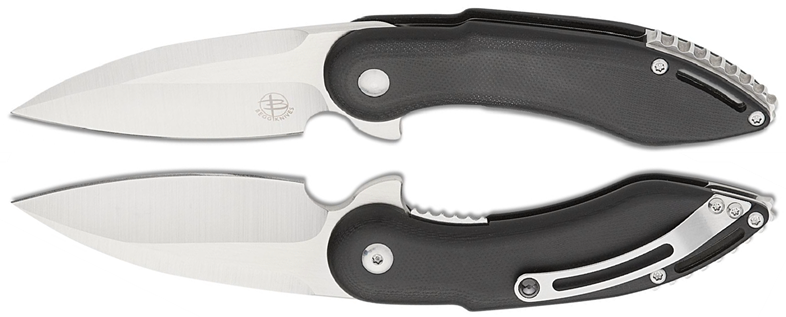
Harbor Freight Icon:
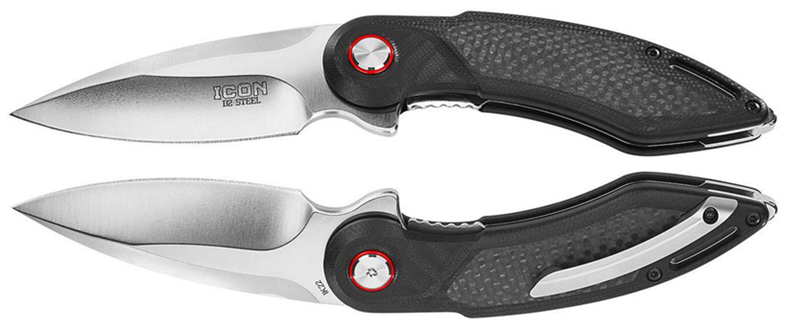
Begg Knives Glimpse:

Harbor Freight Icon:
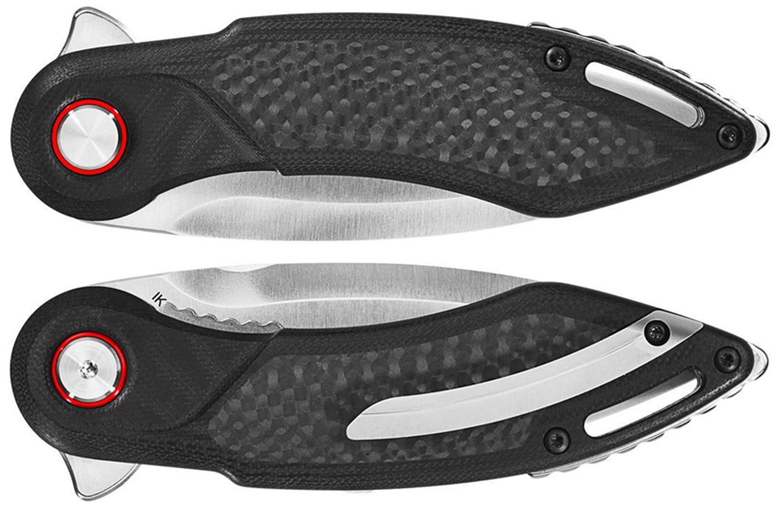
Differences
Does the Icon resemble the Glimpse? Sure! But is it an exact copy? Well, no. In fact, there are quite a number of differences when you examine the details. Compared to the Glimpse, the Icon knife:
- Weighs 7.87 mm / 0.31” oz. less and is 6.35 mm / 0.25” longer overall length
- Is equipped with a blade that is 4.06 mm / 0.16” longer and 0.584 mm / 0.023” thinner, with a 4.06 mm / 0.16” longer cutting edge
- Blade begins its primary bevel further away from the wider ricasso
- Has a flat-ground primary bevel
- Offers a wider, shallower, arc-shaped, finger choil for better comfort
- Comes with scales milled near the pivot and features carbon fiber inlays
- Has a handle that is 5.08 mm / 20” longer handle and 1.02 mm / 0.04” narrower
- Has a pivot presenting a milled, flat-top shape and includes a bright red collar
- Uses a pocket clip that’s milled with no center cut-out
- Includes a polished steel backspacer with smooth, flat-topped crenulations for texture
- Uses black-coated fasteners
- Comes with a lifetime replacement warranty!
Other Knife Designs Similar to the Glimpse
The general, curved, downward swept shape of the Icon is very similar to the Glimpse, but this general knife design shape of the Glimpse is far from unique. There are quite a number of similar, downswept-shaped knives, including just a few examples here:
- Kizer Gemini
- Alliance Designs Jasmine
- CIVIVI Sokoke
- WE Esprit
- Ray Laconico Large Bear
- Spyderco Bodacious
- Spyderco Shaman
- Spyderco LUM Large Chinese Folder
- WE Evoke
- Kershaw Chive
- Kizer Ursa Minor Ki3472
- Vosteed Vallhund
- Buck 112 Slim Pro
Yeah, none of the above knives looks as close to the Glimpse as the Icon, but the point is that the overall shape of the Glimpse is not unique. Indeed, knife designer Ray Laconico is well-known for employing a downward swept arc in his knife handle and blade designs.
Patents
There’s one more point to make here. The Glimpse was first released in 2000, some 25 years ago. If the Glimpse knife was patented, such patents only last 17 years, so by now it would be in the public domain (and the Icon was released in 2023). However, after a detailed patent search for Todd Begg or Begg Knife company, I can comfortably say that the Glimpse knife was never patented (and one attorney makes a claim that you can’t patent a standard pocketknife).
Now I did find that Benchmade did patent their Triage line pocketknife blade design used in its (patent D686,900 on July 30, 2013 for features of some rescue knife blades). After that, Hogue released their own Trauma pocketknife. Benchmade sued Hogue and won an injunction that stopped Hogue from illegally using Benchmade’s patent without permission.
So sometimes (rarely?) stuff like this happens, but before it’s possible, the original product must first be patented, and then any patent violation must occur within the 17-year term of the patent. None of this happened here between the Glimpse and the Icon.
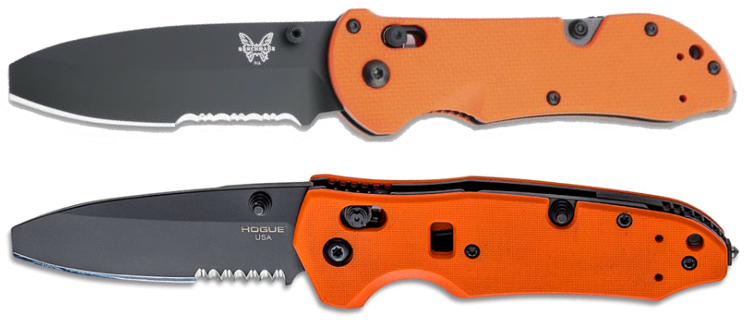
So sometimes (rarely?) stuff like this happens, but before it’s possible, the original product must first be patented, and then any patent violation must occur within the 17-year term of the patent. None of this happened here between the Glimpse and the Icon.
Having your patent expire and seeing competitors use your work for their own benefit must really suck. Ask Benchmade about how it feels to lose their patent protection on their Axis lock or Spyderco about their patent expiration of their Compression lock. It’s disappointing to lose your legal ownership of your invention, but this is how US patent law works, and once patents expire, they go into the public domain for free use by anyone. And since the Glimpse had no patent protection at all and the Icon was released a good 23 years after the Glimpse was released, it appears there’s simply no legally-based intellectual property infringement here.
The Plethora of Similarly Designed Pocketknives in the Market
So is the Icon knife a problem? Well, I have a couple of posts that discuss the issue of counterfeiting knives, and I take these issues seriously. But I recognize that, in the case of pocketknives, there’s only so many shapes and styles that can be used while keeping the tool in question a functional pocketknife, so design similarities will always arise over time.
For example, take a look at the similarities between the Spyderco Military and the Benchmade Mini Pika II. Interesting, isn’t it?
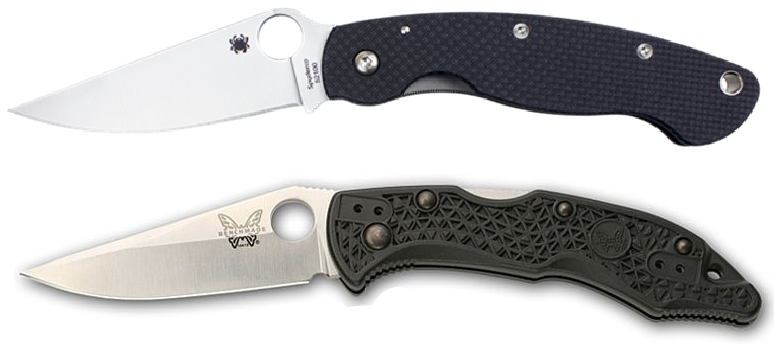
Have you seen the Spyderco Magnitude C212CFP and Benchmade’s 555 S30V Mini Griptilian with the sheepsfoot blade? Hmmm.
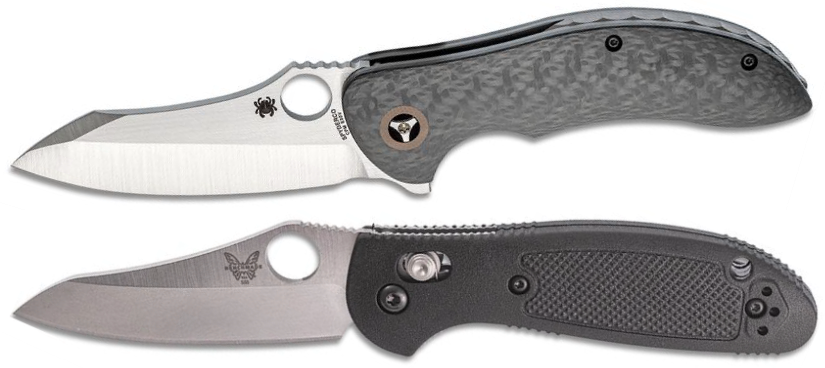
I also see the resemblance between the Benchmade Osborne 940-1 and the Ganzo Firebird F7562.
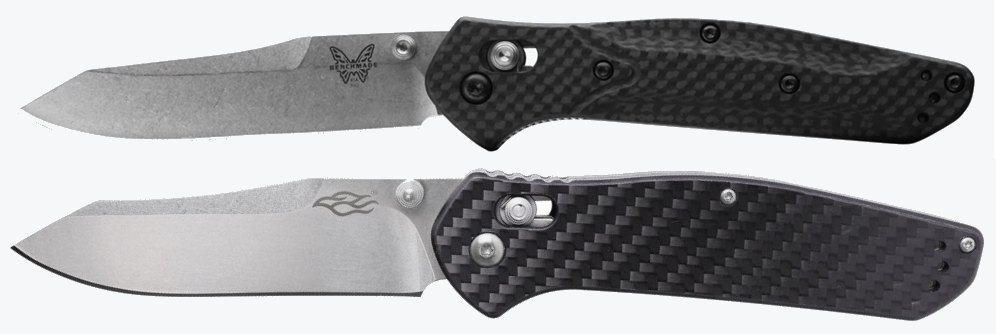
How about the CRK Small Sebenza 21 and the Sanremu 7010? Do you see the likeness between the 2?
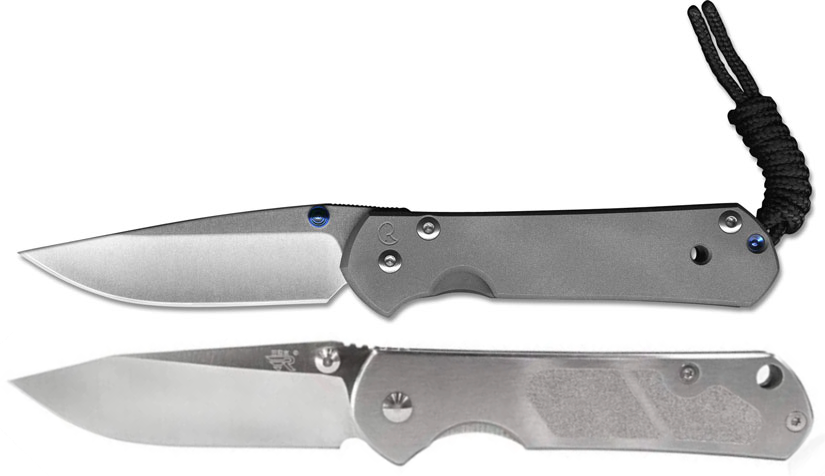
And don’t forget about the Spyderco Techno 3 C158TI3, the VoxKnives Custom F5 by Jesper Voxnaes and the CRKT Pilar. Fairly interchangeable, aren’t they?
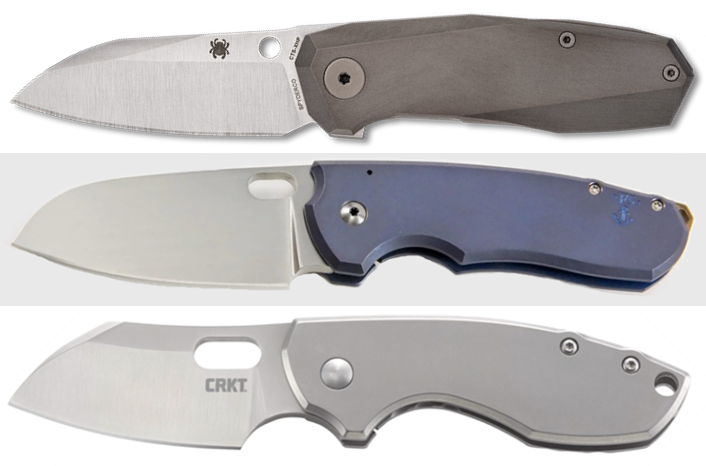
The potential for listing many more, very similar pocketknife designs is almost endless.
Lastly, let’s consider the seminal Barlow knife. It’s believed to have been invented around 1670 by an English cutler named Obadiah Barlow. The design of the Barlow knife is noted for having a set of specific features, including a single spey point blade, whose pivot is located inside of a single, large metal bolster, usually extending down one-third the total length of the handle, located on the smaller end of a tear-drop shaped handle. After more than 350 years, these venerable and distinctive knives are still being made and sold today. I’m not sure of ole Obadiah would be pleased or pissed to see his invention being sold by others after so long, but time marches on, and so do our favorite pocketknife designs.
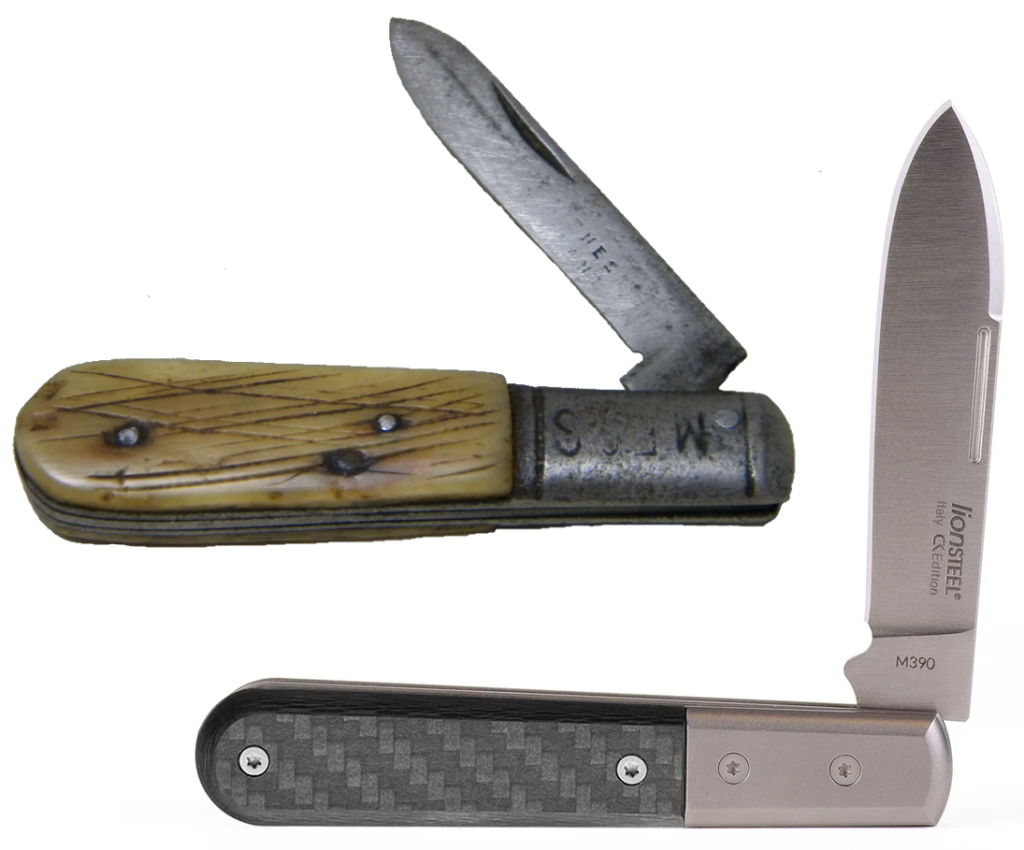
The bottom-line truth is that the modern Icon does look quite similar to the 25-year-old Glimpse, but it’s far from an exact copy. Where each consumer individually draws the line between what we believe to be an illegitimate example of design theft or not is a personal decision, and we vote with our dollars accordingly. If there could be any sort of a legal issue with the Icon, it’ll be up to the folks at Begg Knives to pursue the matter (note that my feelings about outright counterfeits of recently released knives is another issue entirely, and I am vociferously opposed to that!). Given that the Icon knife has been sold by Harbor Freight in their brick-and-mortar stores since at least 2023 without any known legal repercussions to date, I’m guessing there is likely no legal recourse to pursue. And as a reminder, I am not a lawyer, but I did sleep at a Holiday Inn Express last night.
Now let’s get on with the Harbor Freight budget knife fight!
Introducing Harbor Freight’s Icon & Gordon Folding Knives
Harbor Freight is not the first store I think of when I want to pick up a new pocketknife. In fact, it’s not even the 17th! But if you have a Harbor Freight store near you, chances are you will go in from time to time looking to pick up a new, cheap hand tool, power tools, some mechanics supplies, and more. But for what’s assumed to be an extremely inexpensive, glorified imported tool store, they actually have some strangely unexpected items in inventory. For example, if you need to navigate a schooner to the South Seas, you can buy a new vintage brass sextant. If Christopher Walken ever stops by and asks you where he can get more cowbell, you know where to send him. If your Jeep is sick (and when is it ever not?), you can purchase a car stethoscope. When you have lawn varmints, get yourself a solar powered mole & gopher chaser. When you need to entertain your visiting gramps and granny, bring home a bingo balls game set. If the doctor says you need to monitor your hypertension, you can pick up a blood pressure monitor. Of course, when Doggo needs her walkies, grab a new dog leash. And, of course, if you are ever asked to become an auto mechanic for King Charles, be sure to bring your 24k gold-plated ratchet wrench. Weird.
Well, if you find yourself browsing your friendly neighborhood store for any of these things, you might come across their pocketknives (and I’m not talking about their $9 survival knife or their $7 machete – those are different stories!). I browsed my local store, and after spotting these cheap cutters, I thought it might be interesting (BIG assumption on my part) to purchase the 2 knives and determine if they were actually the doggo doodie-quality I assumed they’d be.
The knives in question are:
- Harbor Freight Icon folding knife KDP3 IK24 (note that Icon is Harbor Freight’s premium, in-house brand)
- Harbor Freight Gordon Drop Point Pocket Knife 57584 GK24
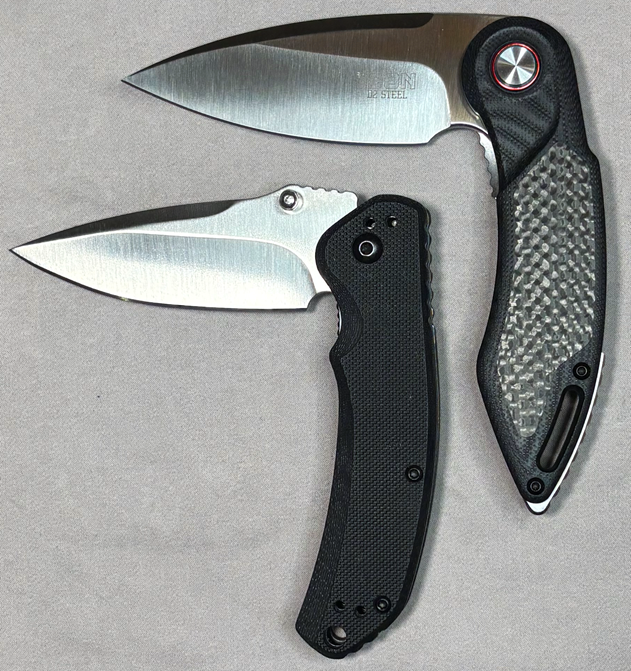
Were they cheap? Oh yeah. The Gordon cost me a whopping $9.99. The Icon was a bit more expensive at $39.99, but I found one of their ubiquitous discount coupon to take the price down to $29.99. For the price, I’d easily call them both ultra-budget knives. Did the price paid reflect their quality? Read on and I’ll let you decide that. I’ll give these 2 discount blades the now famous SharperApex knife review analysis and we’ll see how things worked out.
Details and Specs
This will be a different knife review, as I will be reviewing 2 knives simultaneously. I’ll do my best to keep my thoughts organized and make sure I clearly reference the knife in question when I give my well-reasoned snarky comments opinions and technical facts.
These knives are meant to be part of the expected inventory of the inexpensive, lower-grade tools and products sold by Harbor Freight. The low prices and retailer’s reputation would you have you assume these knives are either junk or just barely a notch above. True? Hmmm?
Blade
Icon: This knife sports a D2 blade (identified as a decent budget blade steel in my series of posts titled Budget Blade Roundup 2024) set in a downswept drop-point shape. The 3-grind blade features a very long swedge (nearly the full length of the blade) that goes all the way to the tip, which sits atop of a long, pointed flat that goes on for nearly 60% of the blade length, followed by a long, deep, flat, saber-ground primary bevel, all done in a fine satin finish. The grind lines between these regions are crisp and clean. There is a good finger/sharpening choil that is lightly chamfered for comfort. However, the side edges of that long swedge are not chamfered. They are not the insanely Spyderco blade spine 90° sharp; I measured the swedge angle to be 16.44°, so the spine edge angle is a slightly softer on the finger 106.44°. Oddly, the blade spine edge before the swedge is chamfered!
In terms of blade markings, on the show side, near the back of the primary bevel, just below the flat grind line, there is a large brand logo (Icon), and underneath that is text that identifies the D2 blade steel, both laser-etched into the blade. On the clip side, the only marking is the laser-etched code IK24 (which I presume to stand for “Icon Knife 2024”), which is located just under the spine on the flat, cut in parallel to the rounded knife handle.
There is no blade-opening assist, such as thumb studs or a blade hole, except for a large, plain, non-jimped, Sperm Whale dorsal fin-like (obtuse angled) flipper tab. Additionally (and disappointingly), there isn’t any jimping at all on the Icon blade.
For out-of-the-box sharpness, when attempting to slice very shallow cuts into the edge of a sheet of 24 lb paper, the blade had no bite; it would instead just tear into the paper. I had to turn the blade to a steeper angle to get the knife to cut. Not great.
There is a small redemption, though. I used my holiday gift to myself, a TSProf Kadet Pro kit (including 5 diamond stones—thank you, Knife Karen Santa! How did you know?), to sharpen the Icon’s D2 blade. The blade was hard and produced a good burr, and better yet, it also let go of the burr when expected. The Icon went from having its crappy stock edge to sporting a very sharp, 17° edge, making it very satisfyingly slicey.
Gordon: The blade, also a 3-grind, drop-point made of 8Cr13MoV (classified as a mediocre budget blade steel in my series of posts called Budget Blade Roundup 2024), has a similar look with a long swedge, a long, pointed flat, and a saber-ground primary bevel, but with this knife, the primary bevel is hollow-ground. The grind lines between the areas are not as crisply defined as the Icon, but certainly not as bad as the hot garbage counterfeit Mini Adamas I recently compared to my real Benchmade Mini Adamas.

The angle of the swedge along the blade spine is 13.53°, and even with that, the spine edge is better chamfered than on the Icon. The Gordon is extremely light on blade markings. The show side is blank! The clip side has nothing except for a laser-etched code GK24 (which I presume to stand for “Gordon Knife 2024”), which is located on the ricasso, cut in parallel to the angled knife handle. The blade has a 4-cut set of coarse, shallow but surprisingly sharp jimping along the thumb ramp to the thumb studs.
With regard to blade opening assists, the Gordon offers both a pair of thumb studs and a large, plain, non-jimped, Great White Shark dorsal fin-like (a less obtuse angle than the Icon) flipper tab. Hey, this is oceanic wildlife I’m talking about here! Go compare for yourself! Google is free.
For out-of-the box sharpness, the Gordon’s 8Cr13MoV blade makes the new Icon’s D2 blade seem quite sharp (it wasn’t). The Gordon just tore paper, not cut, regardless of the approach angle. This knife came with a really crappy edge. Boo!
I did use my TSProf on the Gordon as well. Whereas the Icon’s hard D2 blade took a very good edge from diamond stones, the Gordon’s 8Cr13MoV steel was weirdly soft. It burred easily, but it would not let the burr go! I had to wonder of the blade was made from a lead-mercury-based alloy! In addition, the original edge bevel was beyond poor. It did not have a straight edge nor was it evenly done per side. I had to completely reprofile the original, garbage edge, and it wasn’t easy to do, given the significantly high ductility of the steel. Despite the significant unevenness of the primary bevel (ooh, a foreshadow!), the edge finally got “sharper”. But let’s be clear – it was nowhere close to the good edge of the resharpened Icon. And unfortunately, the new 17° edge appears to suffer from the blade steel’s relatively poor by default edge retention. But in this case, it felt like the blade wasn’t actually heat treated correctly (who needs a heat treat? Pop it in the oven while we’re baking the lasagna), much less optimally (who needs cryo? Pop it in the ice cube bin for a couple of hours). But, seriously, how hard can you make a lead-mercury-alloy, anyway?
D2 and 8Cr13MoV TECHE
When I can get the ratings data for the knife steels I review (I primarily gather the data from the authoritative KnifeSteelNerds.com as available), I include it here in a new section I call TECHE. What does that mean? Well, just look below.
Note that all but Hardness Range are based on a scale from 0-10; Hardness Range is based on the Hardness Rockwell C scale.
| Blade Properties | D2 Ratings | 8Cr13MoV Ratings |
|---|---|---|
| Toughness | 3.5 | 6 |
| Edge Retention | 5 | 3 |
| Corrosion Resistance | 4.5 | 7.3 |
| Hardness Range1 | 59-60.5 | 60-64.5 |
| Ease of Sharpening2 | 5 | 8 |
- Hardness Range data was gathered from KnifeSteelNerds.com.
- Ease of Sharpening data is not a rating produced on KSN, so is an average of data from multiple sources.
Blade Dimensions
Icon: The plain-edged D2 blade measures 80.13 mm / 3.16″ long with a cutting edge length of 73.39 mm / 2.89″ (the big choil makes up the lost edge length). The blade height is 29.58 mm / 1.16″ tall and the steel is 3.23 mm / 0.127″ thick at the ricasso. The calipers reported the main bevel edge thickness as 0.58 mm / 0.023″. The primary bevel angle is 5° with an edge angle of 20° of the show side and 18° on the clip side (yeah, the edge bevels are not the same).
Gordon: This knife’s 8Cr13MoV blade spans 74.90 mm / 2.95″ in length, sporting a 72.47 mm / 2.85″ cutting edge (the choil on the Gordon is quite a bit smaller than on the Icon). The blade height came in as 25.68 mm / 1.01″ and the blade thickness was measured at 2.60 mm / 0.10″. My calipers were put to use measuring the main bevel edge thickness as 0.72 mm / 0.028″. Since the Gordon came equipped with dual thumb studs, I measured their span as 13.68 mm / 0.54″, which compared to the knife handle thickness, 12.78 mm / 0.50″, means the thumb studs slightly stick out beyond the knife body. It’s not much, but it’s worth mentioning in case you’re one of those who can feel a dried pea placed underneath a dozen mattresses.
A close look at the edge bevel on both sides of the blade reveals significant inconsistencies in the maintaining the right angle. My goniometer reports that that the primary bevel is 4° on the show side and 3° on the clip side. However, the edge bevel is where it gets weird. The show side comes back as 23° and the clip side is 14°! While measuring the primary bevel angle on a hollow-ground blade with a laser goniometer is sus to say the least, a comparative 9° difference per side is more likely to be attributed to very low levels of manufacturer quality control rather than an anomaly with the goniometer. It’s a bloody mess, I tell you. I guess if you want to sell a knife for $10, you can’t afford any sort of quality control, can you?
HRc Rating
Neither knife has a published HRc rating. I thought I had at one point seen an HRc figure for the Icon, but I could not find that again. The Harbor Freight webpage for the Icon only says it has “superior hardness”. Superior to what? The Gordon knife? A lead fishing weight?
Unfortunately, it seems my slick, albeit cheap-as-dirt, Leeb Rebound Hardness Tester is not working right anymore. I get crazy low hardness figures that simply don’t make sense, even for these cheap knives. I guess I need a better hardness test. Anyone care to sponsor me to buy a Rockwell Hardness Testing Machine? I’ve been eyeing this one as a starter. Unfortunately, due to the excuse of these machines’ so-called “sensitivity”, sellers often charge shipping costs at nearly the price of these machines. Sheesh. I’ll need a sponsor for sure.
Opening Mechanisms
Icon: The Icon offers only 1 method for opening the knife: a large, non-jimped, Sperm Whale flipper tab (see earlier sections for details on this joke). The knife’s ball detent, fresh out of the box, is ridiculously heavy, so it makes using the flipper tab needlessly difficult. The detent ensures you can’t shake the knife open, and the big, angled swedge all but prevents you from pinching the top of the blade spine and pulling it out! So how do you open this recalcitrant cutter?
I found a solid solution! The blade really needs a set of thumb studs, so I added my own! I found the Kwik Thumb Stud on Amazon, a bolt-on thingamabob with a deep kerf cutout across its side that sits on top of the blade spine and uses a headless screw with a very small hex socket to attach it (I recommend adding a smidge of blue Loctite to keep the screw secured). To place it, I had to work around the really long swedge, but I did find a spot along the rear of the blade spine that allows the stud to fully attach, not hit the handle when opened, not hit the surprisingly tall liner lock release tab when closed, yet allows for good thumb access to the stud when the knife is closed. What I like most out of this funky-looking, half-on, half-off stud arrangement is now the Icon’s really heavy detent works in my favor, as when you apply a solid push of the thumb to the stud, the knife blade practically bursts open with an impressive whack! (Note: I do not have any affiliation with this add-on product, but to make my point, I did not add a link to it. Google is free!)
Gordon: This knife blade comes out-of-the-box (it’s not really a box, but instead a cheap, half trapped blister packaging with full card–meh!) with 2 means to open the knife: a large, non-jimped flipper tab and a pair of long, cylindrical thumb studs with a shallow-domed end. Oddly, the thumb studs have a cut ring around the stud where the dome meets the cylindrical shaft, and the ring edges are actually quite sharp! Nice try, Gordon, but this is a failed effort.
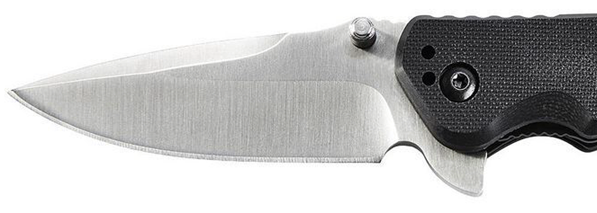
The detent is not as heavy as on the Icon, but it’s firm enough to give the knife a reasonable break, prevents a shake open, and when using either opening method, it pops satisfactorily.
Locking Mechanism
Icon: This knife uses a liner lock to engage with the tang of the blade. I noted when it was brand new that the liner was not fully on the tang. Even right now, as I write this, after having opened and closed the knife many times, the liner is maybe 33% on the blade tang. This is better than before, and it seems to be breaking in. Luckily, the lock easily passed a reasonable spine whack test. The top edge of the liner release tab is cut lengthwise in a wavy, jimping pattern ( I suppose this could be the only place that jimping is used on the Icon!) and quite notably, stands unusually proud of the handle. This makes access to the liner tab very easy, and the liner disengages easily with a push of the thumb. However, the proud liner release tab on the open knife rests right where your finger sits in the recessed handle area behind the blade guard (aka the closed blade flipper tab). The tab’s lengthwise jagged edge sort of feels like a very dull saw blade resting against the first joint line on your index finger. Is it a problem? I wouldn’t want to use this knife with a tight grip for an extended period of time, but it’s not hurtful as BeezBlades often says. Will it bother you? That’s for you to decide.
The locked knife displays no blade play, no lock stick, no pivot lash and no double clutch. It works as expected, and with a break-in period, the liner will hopefully continue to engage better and better with the blade tang.
Once the liner release tab is pushed aside to close the knife, the blade guard falls safely onto your thumbnail, protecting you from the cutting edge, so you can move your thumb aside to allow the blade to fall closed. The pivot’s ceramic ball bearings help the blade fall closed at a predictable, comfortable, even somewhat measured pace. The smoothness of the lock is one of the best features of the Icon knife.
Gordon: Like the Icon, the Gordon uses a liner lock on the blade tang. Brand new, the liner engagement with the tang was approximately 50% at a minimum, right up in there. The liner release tab was similarly equipped with a lengthwise shallow jimping pattern, but was nowhere near the height above the scales like the Icon.
The thumb studs were accessible thanks to finger scallops cut into the scales, leaving plenty of room to engage your thumb on that rounded (but slicey sharp) thumb stud. The blade opens with authority. But this is where the good news ends.
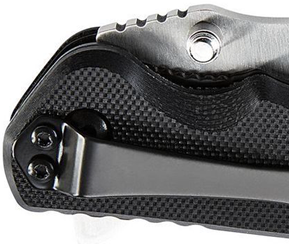
Using the Gordon knife’s liner lock was not a good experience. In fact, it was crap. The lock release tab has a crazy amount of lock stick. It’s as if the bloody thing was suddenly welded on the blade tang! It is extremely difficult to move the liner release tab aside with one hand so you can close the knife. And then, once you do, you have to deal with the worst case of double-clutch I’ve ever experienced. The detent is so poorly designed that if you don’t push and continue to hold on to the liner release tab far longer than you should need to, the blade immediately stops falling, hanging on the detent ball.
Lastly, the blade has a pretty bad case of pivot lash. When half open, the blade wiggles a fair bit, indicating the manufacturing tolerances are utter shite. Yeah, I know this is a $10 knife. But if the product quality corners needed to be cut so deep to get the price down to $10 US retail, but resulting in such shoddy product quality, I suggest Harbor Freight reconsider its priorities.
Knife Body & Scales
Icon: Let’s look at the Icon handle. It dons a pair of smoothed black G-10 scales with carbon fiber inlays on both sides. These scales are not contoured, but are very comfortably chamfered along all the scale edges you’ll touch when holding the knife. Both scales have a region surrounding the pivot milled down to a deeper level, which extends downward to the area along the bottom where you need access to the liner lock release tab. And if you add the aftermarket thumb stud attachment as I did, those milled scale cutouts allow for perfect access to the new stud. Lastly, the spine of the closed, downswept blade runs right along the raised notch at the underside of the handle, creating a smooth, svelte look (although it is slightly off as the blade sits just a bit too deep into the handle to perfectly match the flowing lines of the scales). I can honestly say that this is a very good-looking handle, and when combined with the downswept blade, the design looks sort of like a really handsome Begg Knives Glimpse! This is an unexpected level of aesthetic detail on a sub-$40 knife (sub by 1¢!).
The Icon scales are really very smooth, which means they are very slick. Keep your hands clean and dry when using this knife or you’ll earn yourself a big, deep gash in your hand. The full-length steel liners, of which the show side is milled for weight reduction (it’s a tad difficult to mill out the liner lock side, isn’t it?), are nested in the G-10 – a nice touch. A pair of stop pins, commonly attached to the knife handle above the pivot, are attached to the Icon blade itself and run along curved notches in the scales that use the liners to backstop the opening blade. Due to this setup, it resolves the concerns about stop pins hitting the thinning blade choil.
The Icon adds a nice pivot to the design. It’s a smooth-milled, flat-topped, captive steel pivots with a T8 socket on the clip side, encircled with thin, red pivot collars that give it a nice little pop of color on an otherwise basic black and polished steel ensemble. The pivot runs on ceramic ball bearings which gives the blade the smooth ride I’ve already mentioned.
The knife is equipped with squared-off, crenulated, polished steel backspacer that extends up 32.7% up the handle. Interestingly, the backspacer also extends out 3 mm / 0.118” beyond the back of the handle. Is that supposed to be a glass breaker? It doesn’t come to a point, so it’s not going to work very well for that. Perhaps it’s just a decorative touch. It’s different from the Glimpse, which has its sawtooth backspacer texture continue around the corner of the back of the handle. The 3 last guys who care about lanyards, Jordan, Kent, and Owen, will be quite pleased with the Icon, as there is an entire slot cut into the back of the scales to support your lanyard habit. The rest of us don’t really care.
Gordon: The Gordon handle is more budget knife standard fare. The peel ply-texture of the black G-10 scales, which give them a more grippy feel, look much more blocky than those of the Icon. There’s no chamfering here, just an angular cut of varying angles running along the perimeter of the scales. The edge cuts are shallowest near the thumb stud / liner lock release tab areas, especially along the finger scallop, making those knife features much more accessible.
The handle has full-length steel liners that are not milled out for weight and are stacked (rather than nested) beneath the scales. The handle has 1 stop pin installed above the pivot that works as both opening and closing stops (when closing, the flipper tab has a thin slot underneath that shoulders around the backside of the pin). Such a design precludes any concerns regarding the closing stop pin hitting the blade in the thinned-out part of the choil.

The Gordon pivot looks like a pair of black-coated, button-top screws with T8 sockets on both sides. Oddly, the knife comes with the clip installed tip-down, which blocks access to the pivot screw on that side (yeah, I know the trick: you remove the clip and install it correctly on the tip-down end!). The pivot does run on some sort of bearings. Imagine that – a sub-$10 knife comes equipped with pivot bearings! Wow! (yawn) I hope you like your knife tip-down; the cursed T6 screws used here are as soft and fluffy as black marshmallows. I had to press my genuine Wiha-made Torx bit driver down like a hydraulic press to stop continuing the strip those crappy screws. Argh!!
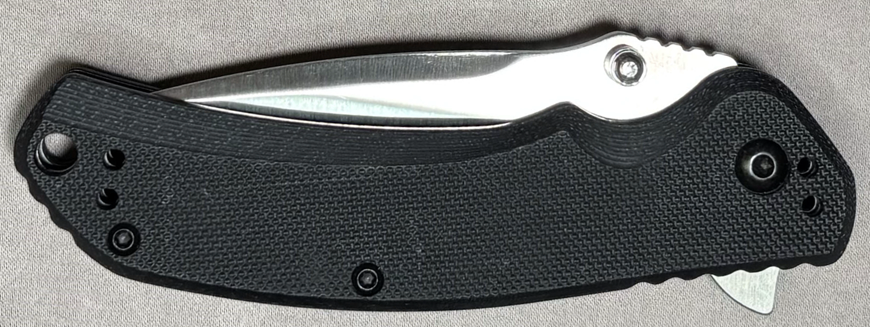
There is no backspacer on the Gordon. However, there is a plain, cylindrical post at the rear of the handle that Jordan, Kent, and Owen can use to add their signature lanyards and fobs. Oh boy!
Handle Dimensions
Icon: Let’s cover handle dimensions for the Icon. The handle length is 111.76 mm / 4.40″, making the blade-to-handle ratio be 0.72. The closed handle height is 32.81 mm / 1.29″, and the handle thickness came in at 12.73 mm / 0.50″. The scale thickness was measured at 3.91 mm / 0.154″ (the nested liners added no additional thickness). As an indication of the knife’s balance, the pivot-center-to-open-knife-fulcrum point is 17.98 mm / 0.71″ down the handle, making the knife a bit butt-heavy.
Gordon: The Gordon knife is just a tad smaller, with the handle length measuring 105.66 mm / 4.16″ with a blade-to-handle ratio of 0.71. With the blade closed, the handle height came in at 31.27 mm / 1.23″, and the handle thickness being 12.78 mm / 0.50″. The thickness of the combined stacked liners & scales was measured at 4.23 mm / 0.167″. Finally, the pivot-center-to-open-knife-fulcrum point is 17.15 mm / 0.68″, so the Gordon is also slightly butt-heavy.
Hardware
Icon: The pocket clip of the Icon is one of its better features. It’s a curved, stonewashed, milled steel clip with a fine groove running down the length of the curve, held in place with a single, black-coated T6 screw. The clip is 54.05 mm / 2.13″ long, spanning 48.4% the length of the handle. I’d even call the pocket clip deep-carry, except it’s mounted in the middle of the curved rear. As a result, a small chunk of the pointed back end of the handle sits above your pocket. Despite that 1 design caveat, overall, it’s nicely done.
The handle only uses 2 screws on each side, and the Icon uses black-coated button-top, T6 fasteners. I’m no fan of T6 screws, especially when one foolishly bought a Torx bit set that was advertised as being made in “S2 tool” steel on AliExpress purely because it was “cheaper”, and then, when encountering a tight T6 screw, it torques your crappy soft Torx driver. I hate that! Don’t you? Let’s retire the friggin’ T6 screws, people!
Gordon: The Gordon pocket clip is pure budget knife equipment. It’s a medium-carry, stamped steel clip whose only special feature is that it has a shiny black coating rather than bare steel. The clip goes 50.50 mm / 1.99″ down the handle, which is 47.80% of the total length of the handle. Otherwise it’s completely unremarkable, except for the fact that the spoon at the end of the clip bends upward at 26°, almost enough to begin being a poking hazard to your hand.
Well, I was wrong. There are 2 annoying things with this clip. Aside from the needlessly high upward bend at the end of the clip, ostensibly done to help you get the clip onto whatever you want your knife clipped to, the clip itself must be made from tungsten (the stiffest metal in the world), as it is basically unbendable. You can’t get it to flex enough to clip to anything! And if you eventually manage to do so, there’s no flat spot on the scale underneath the clip contact point, meaning that the otherworldly compression pressure of the unbendable pocket clip against the peel-ply texture of the G-10 scale will most assuredly grind away any mere fashion-based textiles you might wear as clothes. Do you have a pair of jeans made of Kevlar? If not, use all the money you saved on this $10 monstrosity to find your next pair of ballistic-resistant, button-fly 501s. Hmm, I guess this was 3 annoying things about the Gordon clip. The 1 redeeming factor for this rubbish clip is that Gordon did the Spyderco thing and enabled this clip to be an abomination on either the left or the right, tip-up or tip-down. However, the fasteners are as soft as a 3-minute boiled egg, so relocating the clip may be impossible if you strip those crappy screws, so the redemption fails after all.
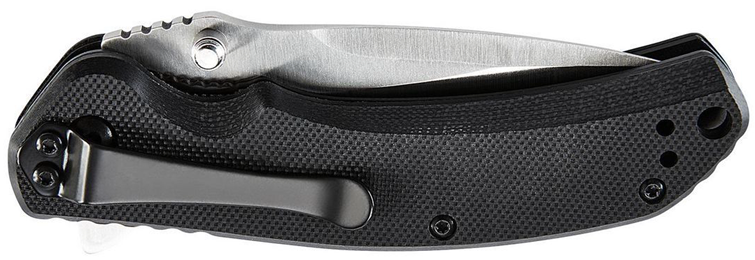
The fasteners used here appear to be identical to those used on the Icon: black-coated button-top, T6 fasteners, 2 per side. Damn the cursed and baneful T6!
Ergonomics
Icon: We’ve already touched on much of this in earlier sections, but a quick synopsis won’t hurt you all too much (assuming you’ve read all the down this far anyway, as a masochist does). The unusually downswept, 4-finger handle is surprisingly comfortable – I guess I didn’t expect that. Even the softened, raised point near the end of the handle, where the handle curve ends and the flow bends to go straight toward the end, fits between my ring and pinky fingers just fine. The significant chamfering on the edges of the scales really adds to a comfortable grip, but the scales themselves are really smooth, and will feel slippery under some conditions. The milled pocket clip feels tall and is definitely felt, but it doesn’t really dig into my hand.
The lack of jimping (or even a thumb ramp) on the blade spine means your thumb is constantly looking for a place to settle in, unless you add the aftermarket thumb stud as I mentioned earlier. That’ll give your thumb a place to both rest and, when required, push against when you need the pressure. Just be sure to install the stud tightly behind the swedge begins and use a good threadlocker to ensure it remains in place. The handle spine, above the area of the milled-out section above the pivot, has a slight recessed section that could be a place to rest the thumb, but I prefer to have my thumb a bit more forward than that.
The backside of the blade’s flipper tab serves well as a comfortable fingerguard behind the choil, which builds confidence when pushing the blade to do its work. If you need to choke up on the knife, the wide choil is great for the index finger, but the disappointing absence of blade spine jimping is really noticed. The liner lock’s unusually tall release tab when holding the open knife is felt by your index finger, especially if you grip the handle so that the tab hits in the center of the middle phalanx of the finger. It’s felt less so when your grip puts the tab at the distal interphalangeal joint (between the distal and middle phalanges of your finger). You still feel it, but it’s not as distressing there.
The backspacer’s polished surface, more of an aesthetic touch, feels fine in the hand.

Gordon: As above with the Icon, some elements here have already been mentioned, but a recap is worthwhile. The handle’s peel-ply textured G-10 scales feel grippy enough without feeling like you’re rubbing a hard-cheese grater against your palm. The finger choil, set behind the open flipper tab fingerguard, is fairly small. If you have portly, kielbasa fingers, you won’t be comfortable. Thankfully, the handle easily accommodates my Knife Karen hands with a 4-finger grip. At least the flipper tab makes a serviceable fingerguard when the blade is open.
The pocket clip, which I moved to the correct, tip-up position, is not as bad as it could be with the steeply bent spoon at the end of the clip. This is because the clip is not crazy long (looking at you, Civivi & Sencut!), but also because the compression pressure of the insanely stiff clip makes it hug the scale much closer. I guess that is a minor benefit of this otherwise all but unusable clip!
The knife has a little bit of jimping, but most of it is on the handle itself, along the spine at the front and back. These are coarse, rounded and widely spaced, with 3 jimp cuts I the rear and 6 jimp cuts at the front. The blade spine itself has 4 jimp cuts up to the thumb ramp, also widely spaced, but these are actually squared off, giving them quite sharp edges! All in all, this attempt at jimping may look okay, but is a failure for knife usability. It doesn’t help with gripping the knife and actually may shred the pad of your thumb’s skin in hard use. That’s nice, isn’t it?
Weight
Icon: The Icon knife weighs 110.24 g / 3.89 oz., what some might call a somewhat chonky weight for a knife with only an 80.13 mm / 3.16″ blade. I personally prefer a knife with a bit of heft. I appreciate the solid feel in the hand. I’m definitely not sold on the trope that a knife should weigh as many ounces as the blade length measures in inches. However, as some people believe that’s a thing, the weight-to-blade-length ratio calculates to 1.22. Give me a chunky monkey and I’m happy.
Gordon: The Gordon knife comes in at 101.65 g / 3.59 oz., another big butt gal, given the blade length of 74.90 mm / 2.95″, and thus has a weight-to-blade-length ratio of 1.23. Good times.
Original Packaging
Neither knife comes in a hinged hard case with a padded interior and includes fun stickers and nice microfiber cloths as do Winterblade knives. Then again, these low-cost (sub-$40) budget knives aren’t close to the quality of a Winterblade, but nor are they as expensive. So we (kinda) get what we pay for here.
Icon: The Icon comes in a sturdy, printed straight tuck end with plastic hang tab cardstock box featuring a clear plastic front box window, with a full-size piece of molded orange foam securing the knife, and nothing more. It’s not the worst packaging I’ve seen (that one’s coming up in a future review), so it’s serviceable for the price.
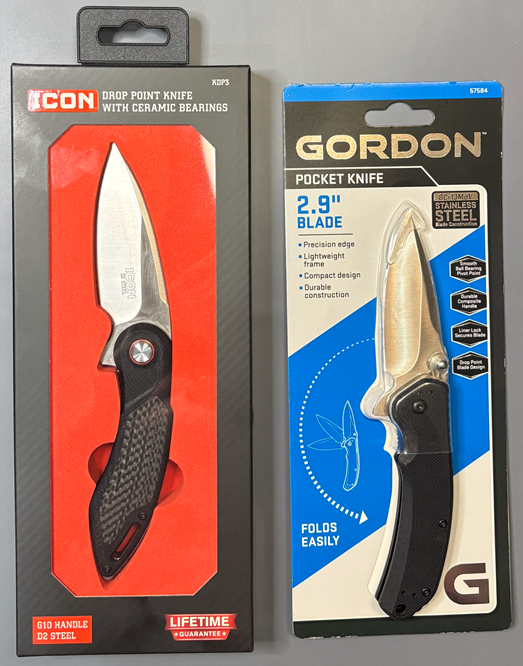
Gordon: As the Gordon knife is a $10 knife, you can’t realistically expect much, can you? Well, your expectations are fulfilled here. The knife ships in a half-trapped blister packaging with full card. There’s no room for anything else. But hey, the card has black, blue and silver printing on it! Whoop-de-doo.
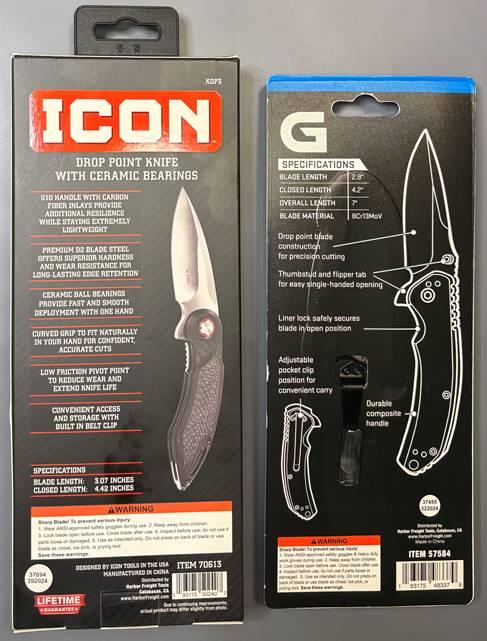
Knife Karen Nitpicks
A Mobius strip walks into a bar, sobbing. The bartender asks, “What’s going on?”, to which the strip replies, “Where do I even begin?” This is how I feel about these Harbor Freight knives. I know I’m supposed to consider the cost of the knife in this process. Pshaw! I’m here to call out inadequacies and disappointments of any knife I review. If I didn’t, you all would miss the important opinions I have to share! (pshaw!) But instead of complaining to the manager about everything being a problem, I’ll put like this:
- Harbor Freight knife brands are apparently unfamiliar with hardened screws. They strip more often than Gypsy Rose Lee at a Minsky’s Burlesque show.
- The Gordon closing action does more double-clutching than a Model T in a bumper-to-bumper, commute home. Yikes!
- The Gordon pocket clip is so stiff that you need the jaws of life to attach it to your pocket.
- There is no feature finer than the Gordon lock liner. The tang jams the liner, which makes me a whiner. If I find the designer, he’s earned himself a shiner!
- Gordon’s suspect slicer steel was so soft that successfully sharpening that sucker was seriously stressful.
- The Icon liner lock release tab must have been influenced by Jim Morrison, because girl, it couldn’t get much higher.
- The lack of any jimping means I won’t be simping for the Icon blade.
- The Icon’s detent is nearly as heavy as a 1970s big block Chevy.
- The overall design of the Icon knife looks really familiar, even at first Glimpse.
Prices
Gordon: Can you say “cheap”? That’s it. Well, to be clear, the Gordon is the truly cheap knife. Harbor Freight charges a single Hamilton and gives you back change. This knife is less expensive than a regular meal at a fast-food joint. Sure, you can also go to KnifeCenter and buy slipjoints from Schrade or MAM in “stainless steel” (I warned you about this in my recent post about junk budget steels), maybe a super-skinny SZCO knife or a tiny Baladeo where the blade steel is not even listed, or even a Cold Steel in 5Cr15MoV (a butter knife will hold a better edge than 5Cr steel). Still, $9.99 is pretty cheap!
Icon: The price of the Icon is a comparatively lofty $39.99 (unless you can find one of Harbor Freight’s ubiquitous 25% off coupons in your neighbor’s recycling bin, which brings down the price to $30). Now in the world of budget knives these days, you have a fair number of options at this price configuration. Once again at KnifeCenter, I count 77 knives with D2 blades measuring at least 3” and G-10 scales. You’ll find such brands as CJRB, Kubey, Petrified Fish, QSP and others. If you look for sale discounts, you can even find a knife there equipped with a 3+” 14C28N blade (rated the best budget steel in my budget blade steels round-up post) with either a G-10 or stainless steel handle. But that’s it. The Icon price value proposition is pretty compelling after all.
Verdict
When buying a budget, store-brand pocketknife from Harbor Freight, choosing the sub-$10 knife is worrisome, as this is almost always dubious proposition. After all, how can it be good? And if you instead choose to pay for the other knife, an in-house premium brand that costs 4x more, are you getting a 400% better knife? That’s what I was hoping to find out.
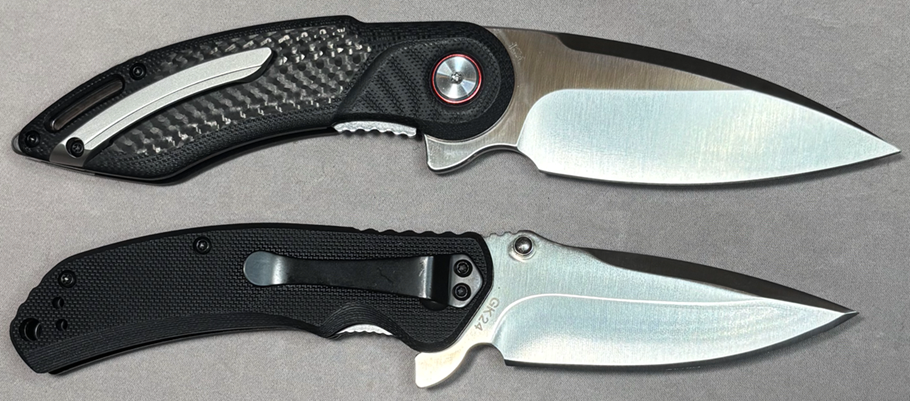
Harbor Freight sells both of these folding pocketknives. The Gordon folding knife offers a near 3”, 8Cr13MoV drop point blade that runs on bearings, dual thumb studs and a flipper tab, a liner lock, black peel-ply G-10 scales, and costs $9.99.
Its in-store competition, the premium branded Icon folding pocketknife (you gotta love the creativity in these names). The Icon has a D2 drop point blade that rides on ceramic ball bearings, a flipper tab (no other opening methods), highly chamfered black G-10 scales featuring dual-sided carbon fiber inlays, a milled, captive pivot highlighted donning dual-sided, red pivot collars, milled steel pocket clip, a polished steel backspacer, and an overall very attractive design that heavily borrowed from the Begg Knives Glimpse line of knives.
Some will say the Icon borrowed too much from the Glimpse. To address that, earlier in the article above, I presented a list of several detailed differences between the 25-year-old Begg Knives design and the 2-year-old Icon knife. Whether those differences are enough is an argument for attorneys. I am not an attorney, although I did sleep at a Holiday Inn Express last night.
Neither of the Harbor Freight knives were free of problems. For example, the Icon:
- Has a very heavy detent, making it difficult to deploy the blade with its flipper tab
- Really needs a 2nd blade deployment method. I chose to install third-party, bolt-on thumb studs (shown above in the article), which immensely eased opening the blade
- Offers no jimping, which would have significantly improved the knife’s usability when choking up on the blade
- Possesses an oddly tall liner lock release tab that, when gripping the open knife, can dig into the flesh of your index finger
- Has a non-ambi pocket clip
As for the other knife, the Gordon:
- Has terrible lock stick; the liner wedges are so deeply behind the tang that it’s very difficult to release one-handed
- Sports an 8Cr13MoV blade that has seriously mismatched bevel angles, and is so soft that sharpening it is a genuine struggle
- • Presents a major double-clutch detent when closing the blade, putting your fingers in danger of a nasty cut (assuming you sharpened this dull blade)
- Pivot displays quite a bit of blade play and pivot lash, indicating lax manufacturing standards
- Pocket clip is ridiculously tight, and with no flat spot on the textured scales, will be a terrible pocket shredder (if you actually get it onto your pocket)
Both knives suffer from 4 common problems between them. No. 1: These knives came with pathetically soft fasteners, the heads of which will easily strip out if not handled right with quality tools. No. 2: Neither knife has jimping on their overly large flipper tabs, needlessly making it harder to deploy the blades. No. 3: Both blades were very disappointingly dull when new. Lastly, No. 4: Both blades were very disappointingly dull when new. Now I realize that, technically speaking, that’s only three flaws, but I thought that last one was such a big one that it was worth mentioning twice.
At the same time, each knife has its share of positive features. For example, the Icon has a:
- 3.16”, drop point blade made of good D2 tool steel with a flipper tab
- Blade boasting nice, crisp grind lines between the swedge, flat and primary bevel with nice satin finish
- Dull blade when new, but took a very good resharpening on a fixed angle sharpener with diamond stones
- Handsome handle with generously chamfered, attractively milled G-10 scales equipped with well-fitted carbon fiber inlays
- Easily accessible and smooth liner lock release
- Pair of nested, full-length steel liners, milled for weight reduction
- Milled, captive steel pivot featuring attractive, dual-sided, red pivot collars
- Steel backspacer with polished crenulations
- Milled steel pocket clip
The Gordon has a few of its own positive features. The Gordon has a:
- 2.95”, hollow-ground, drop point blade made of budget 8Cr13MoV steel, with dual thumb studs and a flipper tab
- Pair of textured G-10 scales that offer good grip
- Pocket clip that can be mounted tip-up or tip-down, left or right sides (if you can get it off without stripping those crappy, soft screws!)
Both knives offer ball bearing-equipped pivots. But most important of all, Harbor Freight supports their products, including these knives, with a free, lifetime replacement warranty (for the original purchaser – save your receipts!). So if you screw up and chip, crack or break one of their knives, bring it back and they will give you a new one to screw up, chip, crack and break. Good stuff. But if that happens to you more than once, I advise that you try to learn from your mistakes and don’t do such idiotic crap again.
The Gordon’s 8Cr13MoV blade should have been a better-than-reasonable budget blade steel considering the knife only costs $10. Typically, 8Cr13MoV is supposed to be better-than-average in toughness and even better yet in corrosion resistance, although it’s pretty lousy with edge retention.
Well, the Gordon blade was seriously dull out-of-the box half blister pack card, and when I attempted to resharpen it, I discovered this knife’s blade was surprisingly soft. Its high ductility made it difficult to remove the sharpening burr, no matter how lightly the stones were passed over the edge. 8Cr13MoV is supposed to be an easy steel to sharpen. Maybe this particular knife’s blade was a dud, but I’d guess that as a $10 knife, the manufacturer largely skipped doing expensive things, like a blade steel heat treat. You know, time is money, and for a $10 retail knife, the profit margins must be super tight, so the number of corners cut here were pretty significant.
The Gordon’s terrible lock stick is also a problem, but perhaps it’ll break in and resolve over time – or not. Its severe double-clutch closing detent and pivot lash speak to machining inaccuracies and lax quality control, so just be careful and (hopefully) you won’t cut a finger off. At least peel-ply scale texture ensures it won’t slip out of your hand and stab your thigh.
The premium Icon knife, at 4x times the cost of the Gordon, is still only $40, and you can drop that to $30 with one of the ubiquitous 25% off discount coupons from Harbor Freight. The Icon offers a better D2 blade and a much nicer milled handle. The looks are of a good quality knife – sort of like the Begg Knives Glimpse, in fact! Don’t let the crazy tight opening detent bother you too much. Hopefully it’ll loosen over time – or not. But by adding a 3rd party opening accessory like the Kwik Thumb Stud to the blade spine, you’ll really improve the opening experience. Relish the preposterously tall liner lock release tab in how it makes opening the blade lock so easy and try to ignore how it might dig into your finger flesh when grasping the open knife. Enjoy the handsome scales and just be sure to remember that if you grip the knife with wet, dirty, greasy, or oily hands, the scale smoothness will become super-slippery and cause you to stab your thigh!
So which knife won the Harbor Freight knife fight? It depends on your budget. The Gordon, even though it’s a $10 knife, is pretty mediocre, given all the problems I identified here. If all you have is $10, then perhaps this is your knife. Just keep your expectations in check. However, if you have a bit more cash to spend, the Icon is a much nicer knife. It has better blade steel, much nicer handles, superior aesthetic details, and good ergonomics.
That said, if you do have $40 burning a hole in your pocket, unless this is an impulse buy, take a look at other budget knives in the sub-$40 range. There are a few out there that have even better budget steels (such as 14C28N), fasteners that aren’t made of lead, more than 1 blade opening mechanism, more polished blade lock mechanisms, and have better manufactured detents. I’m not saying the Icon should not be a consideration. I’m only pointing out that while the Icon’s a pretty good knife, there are a few even better ones available for the same price out there if you’re willing to look for them. Enjoy! ![]()

